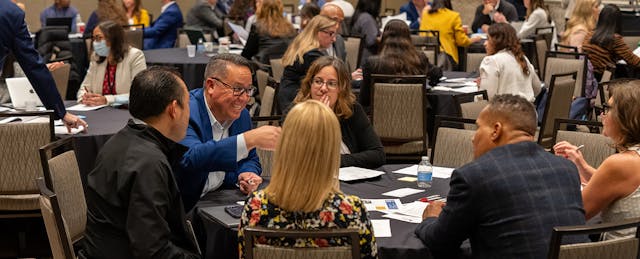“Education is made for students. There is no one who knows what students need more than us.” — Angelica Martinez, 2023 Graduate, Sunnyside Unified School District (AZ)
Historically, research institutions, education entrepreneurs and technology developers have led the research and development (R&D) of education programs and tools. The distance between the “consumers” (the learners and families) and the “creators” (the product developers) has been wide, contributing to an R&D process largely uninformed by those most impacted by inequitable conditions.
Since its inception, the Digital Promise Center for Inclusive Innovation (CII) has focused on bridging that distance by engaging educators, students, families and communities in co-leadership, co-research and co-design of education solutions.
To be clear, community-based organizations have led proximity-centered efforts to transform education for many years. The CII focuses on investing in R&D capacity-building to enable educators, students and families to create solutions with researchers and developers to sustain the work.
Our work is anchored in the following provocation:
“What if the solution to inequities in education resides in foundational shifts — in mindsets, in proximity, in collaborations — and, ultimately, in the co-research and development of equitable, powerful learning with those most impacted?”
In years of collaboration on Inclusive Innovation, we've seen crucial mindset shifts, fostering proximity and collaboration, resulting in novel solutions centered on the voices and leadership of students and families that have been historically and systematically excluded.
Now, we are sharing the stories, solutions and results of this work in our paper, A New Narrative: How Unlocking the Power of R&D through Inclusive Innovation Can Transform Education. Through the words of superintendents, district leaders, teachers and students engaged in the Inclusive Innovation model, and in showcasing the solutions they have co-created, we demonstrate the tenets that drive the work, the resulting R&D shifts and the solutions and outcomes that have emerged.
The Tenets
Often, we speak of the importance of including student and community voices in R&D, but the methods for doing so tend to focus on gathering feedback, which limits the contribution and role of students and families and their influence on education solutions. Effectively centering R&D in students and community requires engaging in new ways of thinking, collaborating and creating — essentially building muscles that enable true co-research and co-design to take shape with those not traditionally included or formally trained in R&D but whose crucial expertise grounded in their lived experiences mean they have a rightful place in the process.
Core to Inclusive Innovation is a set of six tenets: four practice tenets that guide the day-to-day process of engaging in R&D and two impact tenets that guide the outcomes. Additionally, we have developed a set of principles and capacities aligned to each tenet to create the conditions for mutually beneficial engagement.

The Shifts
There is no better articulation of the shifts that occur than the Teaching Is My Favorite Color initiative, involving three districts in southwest Pennsylvania focused on the recruitment and retention of a diverse educator workforce led by educator Deshanna Wisniewski. Dr. Michelle Miller, superintendent of South Fayette School District (Pennsylvania), describes the role of district leaders in this work:
“Humility is one of the most important characteristics of the superintendency, especially in Inclusive Innovation. Superintendents must be listeners and learners to have the capacity to sit back and let others lead. It’s important to have leaders get out of the way and just be there to support the champions of the work.”
This is one example of many in our paper that demonstrates how those with traditional power — leaders, researchers and solution developers — emerge from the Inclusive Innovation and adapt to support the leadership of teachers, students and families in the R&D process. These shifts we have documented have resulted in barriers dissolving between districts and communities, district leaders engaging in shared leadership, teachers and parents working as collaborators to solve challenges and students co-creating learning experiences.
This approach to R&D can offer a new way for schools and communities to move forward collectively as partners in support of student success.
The Solutions
Inclusive Innovation influences the ideas and concepts that emerge as solutions. As a result, the solutions are not the typical products or tools. Because they are designed by those experiencing barriers to teaching and learning, they reflect how educators can support students' needs. Examples include:
- Inclusive Cybersecurity Pathways with Credentials: Over 10 school districts working in partnership with students, families and community business partners to ensure students emerge with marketable, durable skills to transition to the workforce and postsecondary.
- Student-Led Mental Health Teachers Professional Development: Conceived of and developed by students in Bristol Township, Pennsylvania, in collaboration with a mental health professional, to support teachers in ensuring diverse students are heard and valued for what they are experiencing.
- Teacher of Color Recruitment and Retention Initiatives: Designed by teachers of color working in partnership with district leaders, higher education institutions and researchers in southwest Pennsylvania, Ohio and northern Illinois.
- Strengths-Based Data Systems: An initiative in progress at a school district in Washington state designed with school leaders, students and communities.
Journey maps exemplify the phases of Inclusive Innovation and how the work progresses through the R&D process, from the first phase of building trust and relationships in Connect & Commit to expanding solution implementation in Sustain & Scale. An example journey map of the effort in Middletown City Schools to increase the number of Black male educators through their Admiral Squad initiative is below.

The Emerging Outcomes
The research to capture, analyze and document the outcomes involves an ongoing process to understand both qualitatively and quantitatively the impacts of the work. We focus on understanding the shifting mindsets, power dynamics and relationships that result from co-leadership, research and design, as well as the progress towards community-defined outcomes arising from the implementation of the solution.
To date, the solutions created by the districts, students and communities have resulted in:
- Over 800 students, reflecting a uniquely diverse student population, enrolled in our inclusive Cybersecurity pathways initiative across 10 school districts — 25 percent female, 12 percent with learning differences, 43 percent free and reduced lunch, 54 percent students of color.
- A 15 percent increase in students’ engagement and completion of social studies research papers inspired by student-created writing activities designed to boost students’ confidence, interest and skills in writing.
- Over 40 teachers participating in student-led mental health professional development in one district and efforts to start scaling the model within and beyond the district.
- A 25 percent increase in the recruitment of Black male educators in a district.
We invite you to learn more about the Inclusive Innovation journey by reading our paper and joining us as we collaborate with the League of Innovative Schools and districts across the country to bring the power of R&D closer to schools and communities.



